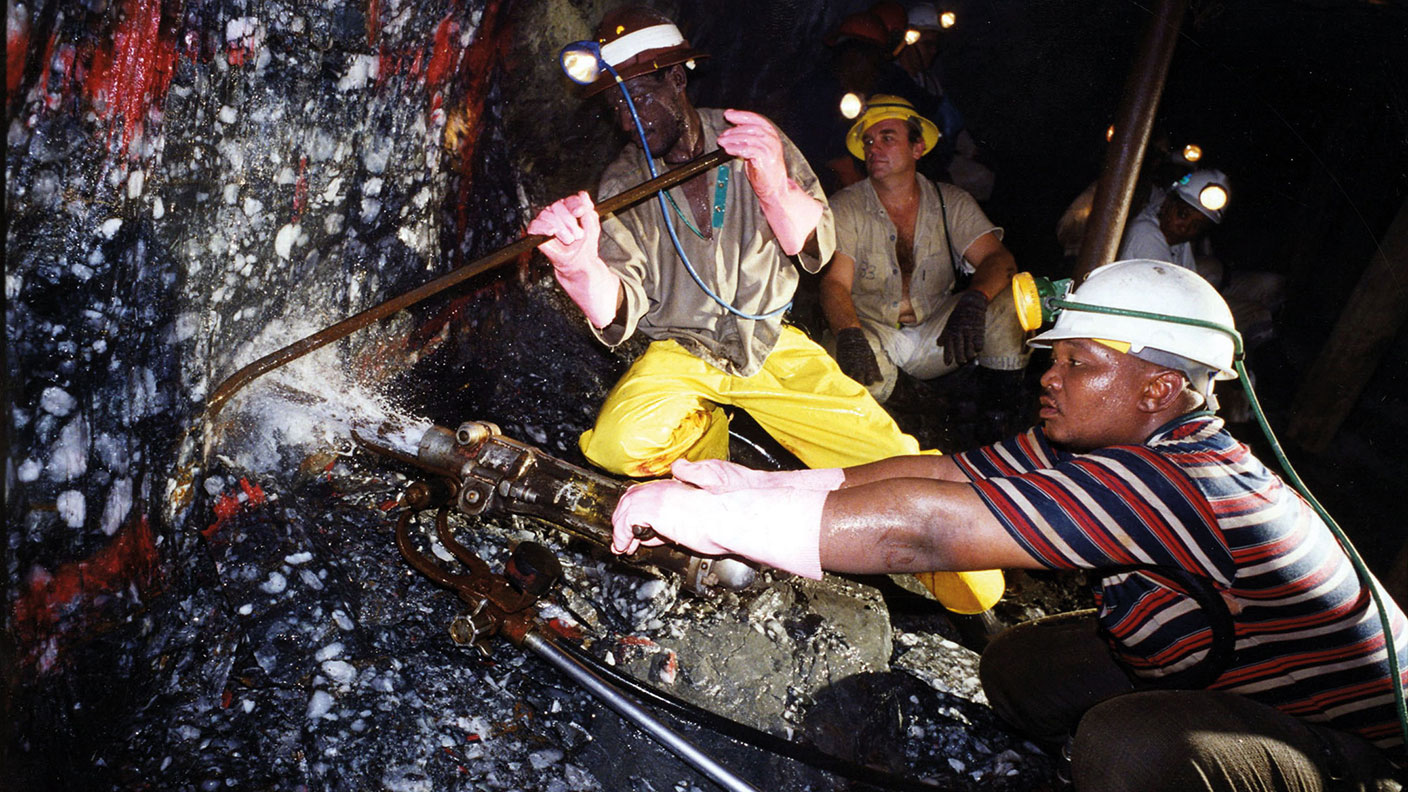Four of the best funds for mining profits in gold
The gold-price upswing is set to endure, says Max King. These funds look the most promising.

Gold’s reputation as the best, probably the only, asset to have preserved its purchasing power over millennia is undisputed. But for mortal investors, it is much less reliable. Its price spends years, even decades, in the doldrums before taking off in an exhilaratingly exponential pattern when the world’s economy hits a trouble spot –only to burn out and fall just when the momentum appears unstoppable.
Every dollar on the gold price would drop straight through to an increase in the profits of gold mining companies if they didn’t sell most of their output forward in order to reduce the risk to profits of a falling price. The benefit of a higher gold price is also reduced by it becoming easier for the workforce to demand higher wages and for equipment suppliers to raise prices. In the longer term, costs per ounce rise as ore grades fall (the best ore is mined first) and as the mine face moves further away from the pithead.
Gold: an indestructible metal
Since gold is virtually indestructible, nearly all the 197,576 tons ever mined (two-thirds since 1950) is still around, mainly as jewellery, private investment, or in central bank reserves. The same can’t be said for mines. South Africa once dominated global production but now lies eighth in the world between Ghana and Mexico. China, Russia and Australia each produce around three times as much. South African production, 30% of the world total in the early 1990s, has fallen by 90% in 50 years; in mid-1998, 75% of mines were said to be unprofitable.
MoneyWeek
Subscribe to MoneyWeek today and get your first six magazine issues absolutely FREE

Sign up to Money Morning
Don't miss the latest investment and personal finances news, market analysis, plus money-saving tips with our free twice-daily newsletter
Don't miss the latest investment and personal finances news, market analysis, plus money-saving tips with our free twice-daily newsletter
The break-even gold price for a mine varies widely, depending on geology, accessibility and the policies of the host country. A few dollars on the gold price can mean the difference between solvency and insolvency, so larger firms are well diversified while smaller ones are more exposed to the gold price and the success of individual mines. Unsurprisingly, BlackRock’s Gold & General Fund, worth £1.3bn, focuses on larger firms. Its top-ten holdings include five of the ten largest gold miners and its top three, Newmont, Barrick and Kinross are respectively number one, two and four in the world. It has returned 156% over five years, including 29% over one, but is slightly down over ten. The £600m Ninety One Global Gold Fund also focuses on big firms and has performed better over five years, but worse over ten.
More interesting is the CQS-managed Golden Prospect Precious Metals (LSE: GPM) with just £42m of assets. Its shares trade at a 36% discount to net asset value (NAV), but it has been one of the top trusts in the market in 2019 and 2020. The top-ten holdings contain none of the world’s ten largest gold miners, yet it has returned 209% over five years and 81% over one. For the bulls, this is the high-risk, high-reward fund to go for.
Better-managed miners
Only 35% of BlackRock World Mining Trust’s (LSE: BRWM) £939m portfolio is invested in gold miners, but the 31% in “diversified” mining means that underlying exposure is higher. The shares trade on a 5% discount to NAV and yield nearly 5%. Though their one-year return of 28% is far behind Golden Prospect, the five-year return of 199% is much closer. The trust has benefited from the strength of metal prices and improvements in the management of mining companies such as Vale, BHP and Rio Tinto.
Global quantitative easing and near-zero interest rates signal higher inflation while the supply of gold is constrained and demand from Asia is rising. So the outlook appears bright. The gold bugs tell a good story but that is not unusual; Mark Twain described a gold mine as “a hole in the ground with a liar on top”. The best time to invest is when the bulls are hibernating, as they were three years ago. The bull market in gold will end earlier than anyone expects, when the clamour from the bulls is deafening – but not yet.
Get the latest financial news, insights and expert analysis from our award-winning MoneyWeek team, to help you understand what really matters when it comes to your finances.

Max has an Economics degree from the University of Cambridge and is a chartered accountant. He worked at Investec Asset Management for 12 years, managing multi-asset funds investing in internally and externally managed funds, including investment trusts. This included a fund of investment trusts which grew to £120m+. Max has managed ten investment trusts (winning many awards) and sat on the boards of three trusts – two directorships are still active.
After 39 years in financial services, including 30 as a professional fund manager, Max took semi-retirement in 2017. Max has been a MoneyWeek columnist since 2016 writing about investment funds and more generally on markets online, plus occasional opinion pieces. He also writes for the Investment Trust Handbook each year and has contributed to The Daily Telegraph and other publications. See here for details of current investments held by Max.
-
 Leading European companies offer long-term growth
Leading European companies offer long-term growthOpinion Alexander Darwall, lead portfolio manager, European Opportunities Trust, picks three European companies where he'd put his money
-
 How to harness the power of dividends
How to harness the power of dividendsDividends went out of style in the pandemic. It’s great to see them back, says Rupert Hargreaves
-
 Leading European companies offer long-term growth prospects
Leading European companies offer long-term growth prospectsOpinion Alexander Darwall, lead portfolio manager, European Opportunities Trust, picks three European companies where he'd put his money
-
 How to harness the power of dividends
How to harness the power of dividendsDividends went out of style in the pandemic. It’s great to see them back, says Rupert Hargreaves
-
 Why Trustpilot is a stock to watch for exposure to the e-commerce market
Why Trustpilot is a stock to watch for exposure to the e-commerce marketTrustpilot has built a defensible position in one of the most critical areas of the internet: the infrastructure of trust, says Jamie Ward
-
 Tetragon Financial: An exotic investment trust producing stellar returns
Tetragon Financial: An exotic investment trust producing stellar returnsTetragon Financial has performed very well, but it won't appeal to most investors – there are clear reasons for the huge discount, says Rupert Hargreaves
-
 How to capitalise on the pessimism around Britain's stock market
How to capitalise on the pessimism around Britain's stock marketOpinion There was little in the Budget to prop up Britain's stock market, but opportunities are hiding in plain sight. Investors should take advantage while they can
-
 London claims victory in the Brexit wars
London claims victory in the Brexit warsOpinion JPMorgan Chase's decision to build a new headquarters in London is a huge vote of confidence and a sign that the City will remain Europe's key financial hub
-
 Reinventing the high street – how to invest in the retailers driving the change
Reinventing the high street – how to invest in the retailers driving the changeThe high street brands that can make shopping and leisure an enjoyable experience will thrive, says Maryam Cockar
-
 The consequences of the Autumn Budget – and what it means for the UK economy
The consequences of the Autumn Budget – and what it means for the UK economyOpinion A directionless and floundering government has ducked the hard choices at the Autumn Budget, says Simon Wilson
